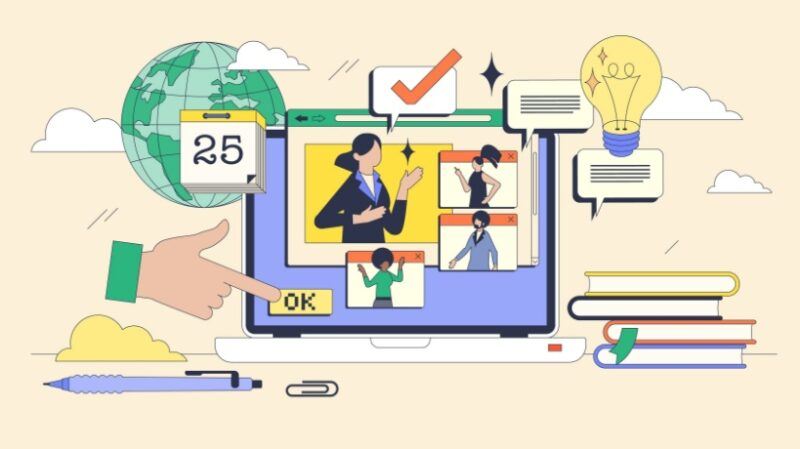
Digital Learning In Education
In the past decade, digital learning has emerged as a game changer in education, revolutionizing how students engage with content, teachers, and each other. Gone are the days when traditional classrooms, with their static chalkboards and textbooks, dominated the educational landscape. Today, technology has ushered in a new era of interactive and flexible learning, creating dynamic classrooms that cater to diverse student needs.
This shift to digital learning is not just about integrating technology into education; it represents a fundamental change in how learning happens. With tools like online platforms, virtual classrooms, educational apps, and Artificial Intelligence (AI), students are experiencing a more personalized, engaging, and accessible form of education. As we look ahead, it’s clear that the future of education will increasingly rely on digital innovation, transforming classrooms worldwide.
How Digital Learning Will Transform Education
Personalized Learning At Scale
One of the most significant transformations brought about by digital learning is the ability to personalize education. In traditional classrooms, teachers are often limited by time and resources, making it difficult to cater to the unique learning styles and paces of individual students. Digital platforms, however, allow for personalized learning experiences on a large scale.
With the help of AI and Machine Learning, digital tools can analyze student performance in real time, providing feedback and adjusting content to meet the learner’s needs. For example, if a student is struggling with a particular concept in math, an AI-powered platform can recommend additional resources or exercises tailored to help them improve. Similarly, students who excel in certain subjects can be given more challenging tasks to push their learning further.
This personalized approach not only enhances student engagement but also improves outcomes. Studies have shown that students who learn in environments tailored to their individual needs are more likely to retain information and perform better academically. Digital learning empowers educators to create these environments, allowing them to address learning gaps and promote student success more effectively.
Enhanced Student Engagement And Interactivity
Traditional learning methods, such as lectures and textbooks, often struggle to keep students engaged in a world increasingly dominated by technology. Digital learning, on the other hand, offers a more interactive and immersive experience. Through the use of multimedia content—such as videos, animations, simulations, and games—students are encouraged to engage with the material in new and exciting ways.
For example, rather than reading about historical events in a textbook, students can now watch documentaries, participate in Virtual Reality (VR) tours of historical sites, or interact with primary source documents online. These digital tools make learning more dynamic and allow students to experience the content firsthand, enhancing their understanding and retention of information.
Moreover, online discussion forums, quizzes, and collaborative platforms enable students to actively participate in the learning process. By interacting with their peers and teachers in real time, students develop critical thinking skills, problem-solving abilities, and deeper insights into the subject matter. This increased engagement fosters a more meaningful connection to the material, leading to better academic outcomes.
Flexible Learning Anytime, Anywhere
Another critical aspect of digital learning is its flexibility. In traditional classrooms, learning is often confined to a set time and place, limiting students’ ability to access education outside of school hours. Digital learning breaks down these barriers by allowing students to access course materials, lectures, and resources from anywhere, at any time.
With the rise of online platforms and mobile applications, students can engage in learning activities from the comfort of their homes, during their commute, or even while traveling. This flexibility is especially beneficial for students with busy schedules, such as working professionals or those involved in extracurricular activities. It also enables educators to offer more diverse learning opportunities, such as blended learning models that combine in-person and online instruction.
Furthermore, digital learning supports the concept of just-in-time learning, where students can access information exactly when they need it. This approach is particularly valuable for subjects that require constant updates, such as technology or business, where staying current with trends and developments is essential. By providing on-demand access to resources, digital learning ensures that students are always equipped with the most up-to-date knowledge.
Bridging Geographical And Socioeconomic Gaps
One of the most significant benefits of digital learning is its potential to democratize education. Traditionally, access to quality education has been limited by geographical location and socioeconomic status. Students in rural areas or developing countries often face barriers such as a lack of qualified teachers, inadequate learning resources, or insufficient infrastructure.
Digital learning addresses these challenges by making high-quality educational content available to anyone with an internet connection. Online courses, virtual classrooms, and open educational resources (OER) allow students from all over the world to access the same level of education, regardless of where they live. This global reach helps bridge the gap between students in privileged and underprivileged communities, promoting greater educational equity.
Additionally, digital platforms often offer more affordable learning solutions. Many universities, for example, now provide free or low-cost online courses through various online platforms. These courses allow students to gain knowledge and skills without the financial burden associated with traditional higher education.
The Role Of Teachers In Digital Classrooms
While digital learning is transforming how students learn, it is important to recognize that teachers remain central to the educational experience. Technology is not meant to replace teachers but to enhance their ability to deliver effective instruction. In digital classrooms, teachers can use data-driven insights to identify student strengths and weaknesses, tailor their teaching methods, and provide targeted support.
Furthermore, digital tools free up time for teachers to focus on more meaningful interactions with students. Automated grading systems, for example, reduce the administrative burden on educators, allowing them to dedicate more time to personalized feedback, mentoring, and creative lesson planning.
Conclusion
As digital learning continues to evolve, it is reshaping classrooms in profound ways. By offering personalized learning, increasing student engagement, providing flexible access, and bridging educational gaps, technology is transforming the future of education. While challenges remain, the benefits of digital learning are undeniable, and its potential to create more inclusive, innovative, and effective learning environments will play a key role in shaping the next generation of education.















